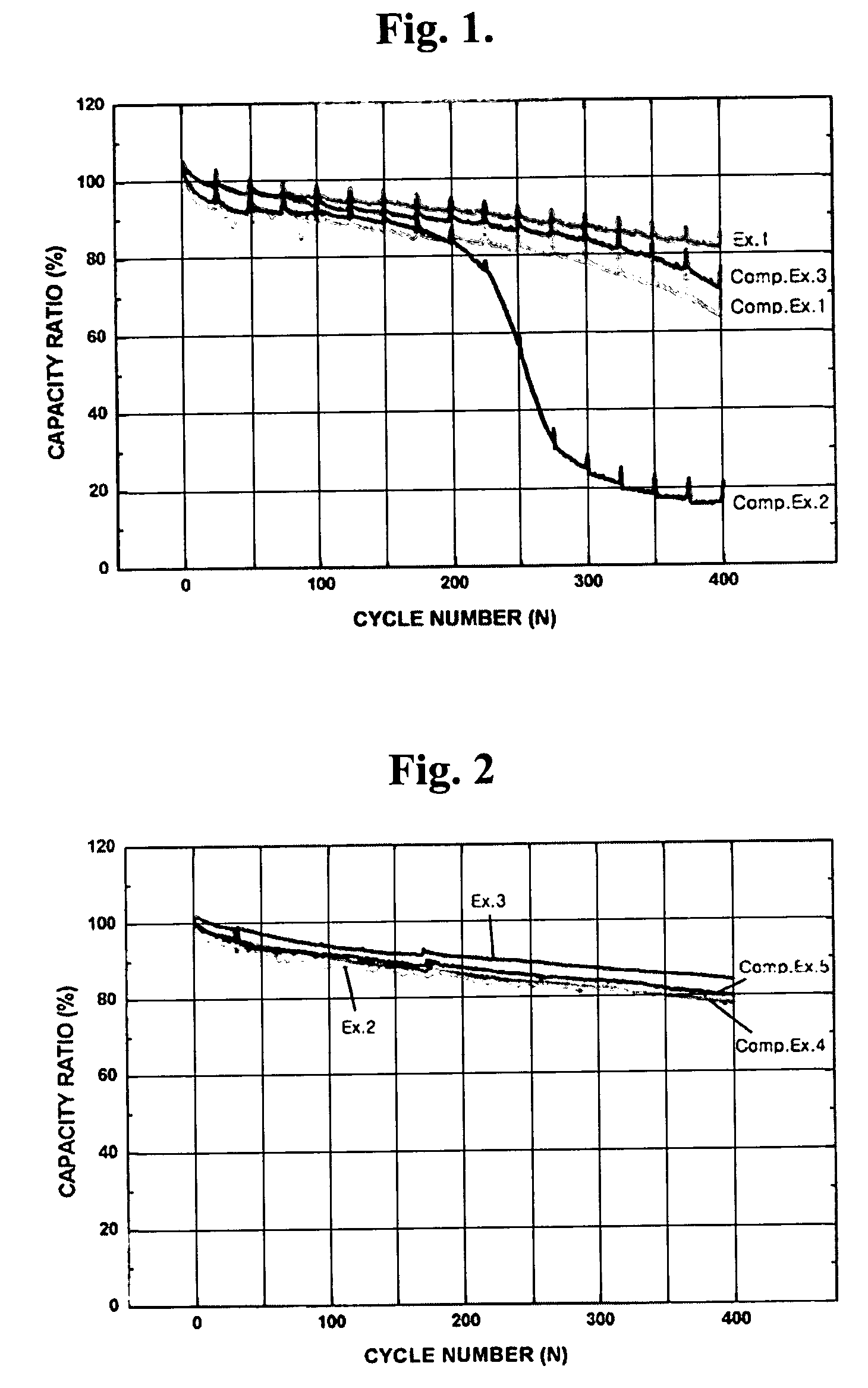Nonaqueous lithium secondary battery with cyclability and/or high temperature safety improved
a lithium secondary battery, non-aqueous technology, applied in the field of non-aqueous lithium secondary batteries, can solve the problems of deterioration in battery performance, storage life characteristics and safety at high temperature, and achieve the effect of improving charge/discharge efficiencies and cycle life characteristics
- Summary
- Abstract
- Description
- Claims
- Application Information
AI Technical Summary
Benefits of technology
Problems solved by technology
Method used
Image
Examples
example 1
[0051] A lithium-ion polymer battery was fabricated in the same manner as in Comparative Example 1 except that iodine in place of the aluminum iodide was added to the electrolyte at the amount of 0.05% by weight. A cycle life test on the fabricated battery was performed in the same manner as in Comparative Example 1.
[0052] Test Result 1
[0053]FIG. 1 is a graphic diagram showing the comparison of discharge capacity ratio at a range of initial cycle to 400 cycles between batteries fabricated according to Comparative Examples 1 to 3 and Example 1. As shown in FIG. 1, it could be found that an increase in the amount of addition of the aluminum iodide resulted in a reduction in the battery cycle life (Comparative Examples 1 and 2), and also the addition of the tin iodide resulted in a reduction in the battery cycle life (Comparative Example 3). However, it could be confirmed that the battery of Example 1 where the iodine had been used at an amount determined in view of the weight ratio ...
example 2
[0056] A lithium-ion polymer battery was fabricated in the same manner as in Comparative Example 4 except that iodine was added to the electrolyte at the amount of 0.05% by weight. A cycle life test on the fabricated battery was performed in the same manner as in Comparative Example 4.
example 3
[0057] A lithium-ion polymer battery was fabricated in the same manner as in Comparative Example 4 except that 2,5-dimethylpyrrole and iodine were added to the electrolyte at the amounts of 0.2% by weight and 0.05% by weight, respectively. A cycle life test on the fabricated battery was performed in the same manner as in Comparative Example 4.
[0058] Test Result 2
[0059]FIG. 2 is a graphic diagram showing the comparison of discharge capacity ratio at a range of initial cycle to 400 cycles between batteries fabricated according to Comparative Examples 4 and 5 and Examples 2 and 3. As shown in FIG. 2, it could be found that, although the single addition of 2,5-dimethylpyrrole or iodine could have an effect on the improvement of discharge capacity ratio (Comparative Example 4 and Example 2), the addition of iodine in combination with 2,5-dimethylpyrrole provided a further improvement in discharge capacity ratio (Example 3).
PUM
| Property | Measurement | Unit |
|---|---|---|
| current | aaaaa | aaaaa |
| current | aaaaa | aaaaa |
| current | aaaaa | aaaaa |
Abstract
Description
Claims
Application Information
 Login to View More
Login to View More - R&D
- Intellectual Property
- Life Sciences
- Materials
- Tech Scout
- Unparalleled Data Quality
- Higher Quality Content
- 60% Fewer Hallucinations
Browse by: Latest US Patents, China's latest patents, Technical Efficacy Thesaurus, Application Domain, Technology Topic, Popular Technical Reports.
© 2025 PatSnap. All rights reserved.Legal|Privacy policy|Modern Slavery Act Transparency Statement|Sitemap|About US| Contact US: help@patsnap.com


